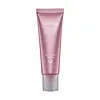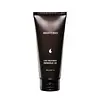What's inside
What's inside
 Key Ingredients
Key Ingredients

 Benefits
Benefits

 Concerns
Concerns

 Ingredients Side-by-side
Ingredients Side-by-side

Glycerin
HumectantWater
Skin ConditioningDimethicone
EmollientButylene Glycol
HumectantMyristyl Alcohol
EmollientPropylene Glycol
HumectantIsopropyl Myristate
EmollientCyclopentasiloxane
EmollientCetyl Ethylhexanoate
EmollientHydroxypropyl Starch Phosphate
Parfum
MaskingSteartrimonium Chloride
PreservativeSodium Benzoate
MaskingGuar Hydroxypropyltrimonium Chloride
Skin ConditioningCetrimonium Chloride
AntimicrobialLaureth-3
EmulsifyingLaureth-23
CleansingPolyquaternium-7
Panthenol
Skin ConditioningBetaine
HumectantHydrolyzed Collagen
EmollientPhenoxyethanol
PreservativeDisodium EDTA
Tocopheryl Acetate
AntioxidantCocamidopropyl Betaine
CleansingC12-15 Pareth-3
EmulsifyingHydrolyzed Keratin
HumectantHydrolyzed Collagen Pg-Propyl Methylsilanediol
Skin ConditioningFumaric Acid
BufferingXanthan Gum
Emulsifying1,2-Hexanediol
Skin ConditioningHydrolyzed Corn Protein
Skin ConditioningHydrolyzed Wheat Protein
Skin ConditioningHydrolyzed Soy Protein
HumectantGlycine
BufferingIsopropyl Alcohol
SolventSerine
MaskingGlutamic Acid
HumectantHydrolyzed Silk
HumectantMilk Protein Extract
Spirulina Platensis Extract
Skin ProtectingCorchorus Olitorius Leaf Extract
Skin ConditioningAspartic Acid
MaskingLeucine
Skin ConditioningPropanediol
SolventAlanine
MaskingLysine
Skin ConditioningArginine
MaskingTyrosine
MaskingPhenylalanine
MaskingCeratonia Siliqua Fruit Extract
MaskingThreonine
Proline
Skin ConditioningValine
MaskingIsoleucine
Skin ConditioningDiospyros Kaki Fruit Extract
Skin ConditioningCamellia Japonica Leaf Extract
Skin ConditioningHistidine
HumectantMethionine
Skin ConditioningCysteine
AntioxidantIodopropynyl Butylcarbamate
PreservativeMyrothamnus Flabellifolia Leaf/Stem Extract
HumectantCaprylyl Glycol
EmollientAscorbic Acid
AntioxidantCitric Acid
BufferingSoy Amino Acids
Skin ConditioningWheat Amino Acids
Skin ConditioningRice Amino Acids
Skin ConditioningOat Amino Acids
Skin ConditioningGlycerin, Water, Dimethicone, Butylene Glycol, Myristyl Alcohol, Propylene Glycol, Isopropyl Myristate, Cyclopentasiloxane, Cetyl Ethylhexanoate, Hydroxypropyl Starch Phosphate, Parfum, Steartrimonium Chloride, Sodium Benzoate, Guar Hydroxypropyltrimonium Chloride, Cetrimonium Chloride, Laureth-3, Laureth-23, Polyquaternium-7, Panthenol, Betaine, Hydrolyzed Collagen, Phenoxyethanol, Disodium EDTA, Tocopheryl Acetate, Cocamidopropyl Betaine, C12-15 Pareth-3, Hydrolyzed Keratin, Hydrolyzed Collagen Pg-Propyl Methylsilanediol, Fumaric Acid, Xanthan Gum, 1,2-Hexanediol, Hydrolyzed Corn Protein, Hydrolyzed Wheat Protein, Hydrolyzed Soy Protein, Glycine, Isopropyl Alcohol, Serine, Glutamic Acid, Hydrolyzed Silk, Milk Protein Extract, Spirulina Platensis Extract, Corchorus Olitorius Leaf Extract, Aspartic Acid, Leucine, Propanediol, Alanine, Lysine, Arginine, Tyrosine, Phenylalanine, Ceratonia Siliqua Fruit Extract, Threonine, Proline, Valine, Isoleucine, Diospyros Kaki Fruit Extract, Camellia Japonica Leaf Extract, Histidine, Methionine, Cysteine, Iodopropynyl Butylcarbamate, Myrothamnus Flabellifolia Leaf/Stem Extract, Caprylyl Glycol, Ascorbic Acid, Citric Acid, Soy Amino Acids, Wheat Amino Acids, Rice Amino Acids, Oat Amino Acids
Water
Skin ConditioningCetearyl Alcohol
EmollientCyclopentasiloxane
EmollientHydrogenated Starch Hydrolysate
HumectantDimethicone
EmollientSteartrimonium Bromide
PreservativeAmodimethicone
Camellia Oleifera Leaf Extract
AstringentBehentrimonium Chloride
PreservativeAminopropyl Dimethicone
Butylene Glycol
HumectantEthylhexyl Isononanoate
EmollientBehenyl Alcohol
EmollientGlycerin
HumectantC12-14 Sec-Pareth-7
EmulsifyingCocamide
EmulsifyingIsopropyl Alcohol
SolventHydrolyzed Silk
HumectantLactic Acid
BufferingBetaine
HumectantTocopheryl Acetate
AntioxidantPEG-14m
Emulsion StabilisingOlea Europaea Fruit Oil
MaskingPersea Gratissima Oil
Skin ConditioningArgania Spinosa Kernel Oil
EmollientAlcohol Denat.
AntimicrobialEthyl Ester Of Hydrolyzed Silk
Skin ConditioningHydrolyzed Collagen
EmollientChitosan
Hydrolyzed Chitosan
Skin ConditioningDipropylene Glycol
HumectantZein
Skin ConditioningHydrolyzed Keratin
HumectantTrehalose
HumectantDipotassium Glycyrrhizate
HumectantSodium Hyaluronate
HumectantIris Ensata Extract
Skin ConditioningCamellia Sinensis Leaf Extract
AntimicrobialUlmus Davidiana Root Extract
Skin ConditioningYeast
Skin ConditioningPyrus Malus Peel Extract
AntioxidantMentha Piperita Leaf Extract
Skin ConditioningPhenoxyethanol
PreservativeDisodium EDTA
Water, Cetearyl Alcohol, Cyclopentasiloxane, Hydrogenated Starch Hydrolysate, Dimethicone, Steartrimonium Bromide, Amodimethicone, Camellia Oleifera Leaf Extract, Behentrimonium Chloride, Aminopropyl Dimethicone, Butylene Glycol, Ethylhexyl Isononanoate, Behenyl Alcohol, Glycerin, C12-14 Sec-Pareth-7, Cocamide, Isopropyl Alcohol, Hydrolyzed Silk, Lactic Acid, Betaine, Tocopheryl Acetate, PEG-14m, Olea Europaea Fruit Oil, Persea Gratissima Oil, Argania Spinosa Kernel Oil, Alcohol Denat., Ethyl Ester Of Hydrolyzed Silk, Hydrolyzed Collagen, Chitosan, Hydrolyzed Chitosan, Dipropylene Glycol, Zein, Hydrolyzed Keratin, Trehalose, Dipotassium Glycyrrhizate, Sodium Hyaluronate, Iris Ensata Extract, Camellia Sinensis Leaf Extract, Ulmus Davidiana Root Extract, Yeast, Pyrus Malus Peel Extract, Mentha Piperita Leaf Extract, Phenoxyethanol, Disodium EDTA
Ingredients Explained
These ingredients are found in both products.
Ingredients higher up in an ingredient list are typically present in a larger amount.
Betaine is a common humectant (a substance that promotes retention of moisture). It's known to be gentle on the skin and can help balance hydration.
This ingredient is best for improving hydration and soothing irritated skin. Studies also show it helps even out skin tone.
Fun fact: Betaine is naturally created in the skin and body. The kind found within cosmetic products can be either plant-derived or synthetic.
Another name for betaine is trimethylglycine.
Learn more about BetaineButylene Glycol (or BG) is used within cosmetic products for a few different reasons:
Overall, Butylene Glycol is a safe and well-rounded ingredient that works well with other ingredients.
Though this ingredient works well with most skin types, some people with sensitive skin may experience a reaction such as allergic rashes, closed comedones, or itchiness.
Learn more about Butylene GlycolCyclopentasiloxane, or D5, is a silicone used to improve texture of products and trap moisture.
D5 is considered lightweight and volatile. Volatile means it evaporates quickly after application. Once evaporated, D5 leaves a thin barrier that helps keep skin hydrated.
It is also an emollient. Emollients help soften the skin and prevent water loss. Silicones create a silky texture in products. D5 helps other ingredients become more spreadable.
Studies show D5 is safe to use in skincare products. We recommend speaking with a skincare professional if you have concerns.
Learn more about CyclopentasiloxaneDimethicone is a type of synthetic silicone created from natural materials such as quartz.
What it does:
Dimethicone comes in different viscosities:
Depending on the viscosity, dimethicone has different properties.
Ingredients lists don't always show which type is used, so we recommend reaching out to the brand if you have questions about the viscosity.
This ingredient is unlikely to cause irritation because it does not get absorbed into skin. However, people with silicone allergies should be careful about using this ingredient.
Note: Dimethicone may contribute to pilling. This is because it is not oil or water soluble, so pilling may occur when layered with products. When mixed with heavy oils in a formula, the outcome is also quite greasy.
Learn more about DimethiconeDisodium EDTA plays a role in making products more stable by aiding other preservatives.
It is a chelating agent, meaning it neutralizes metal ions that may be found in a product.
Disodium EDTA is a salt of edetic acid and is found to be safe in cosmetic ingredients.
Learn more about Disodium EDTAGlycerin is already naturally found in your skin. It helps moisturize and protect your skin.
A study from 2016 found glycerin to be more effective as a humectant than AHAs and hyaluronic acid.
As a humectant, it helps the skin stay hydrated by pulling moisture to your skin. The low molecular weight of glycerin allows it to pull moisture into the deeper layers of your skin.
Hydrated skin improves your skin barrier; Your skin barrier helps protect against irritants and bacteria.
Glycerin has also been found to have antimicrobial and antiviral properties. Due to these properties, glycerin is often used in wound and burn treatments.
In cosmetics, glycerin is usually derived from plants such as soybean or palm. However, it can also be sourced from animals, such as tallow or animal fat.
This ingredient is organic, colorless, odorless, and non-toxic.
Glycerin is the name for this ingredient in American English. British English uses Glycerol/Glycerine.
Learn more about GlycerinHydrolyzed collagen has a misleading name because it is actually a mixture of various proteins/peptides. This ingredient has skin hydrating properties.
Collagen is the most abundant type of structural protein found in your body. In your skin, it is responsible for keeping it firm and youthful.
Hydrolyzed Collagen is created by breaking up proteins into smaller peptide bonds. These peptides act as humectants and emollients.
Humectants are great at holding onto water, keeping skin hydrated. Emollients create a thin barrier on the skin to prevent moisture from escaping.
There is ongoing debate about whether hydrolyzed collagen works because it increases skin hydration. Skin hydration is also linked to elasticity and the appearance of wrinkles.
Collagen or peptide ingredients can be used in the morning or night. They will not increase sun sensitivity, but you should always wear sunscreen during the day.
According to a manufacturer, this ingredient is a great hair conditioner as well.
This ingredient can be extracted from different sources, including:
Vegan collagen is derived from yeast, bacteria, or plant sources. Vegan collagen would go by a different INCI name, such as hydrolyzed soy protein.
The results are varied.
A study from 2021 found hydrolyzed collagen increased elasticity and improved wrinkles in 1,125 participants between age 20 and 70. Another study found increased skin thickness in participants between the ages of 45 to 59.
However, It is difficult to prove that oral collagen will end up working on your skin. Many of the studies using hydrolyzed collagen also add several vitamins and nutrients into the test mixture as well.
Further studies are needed at this time.
Learn more about Hydrolyzed CollagenHydrolyzed Keratin is derived from keratin. Keratin is a large protein that is naturally found in our hair and skin.
Studies show keratin is able to seal broken hair cuticles, helping to prevent split ends and breakage.
As a humectant, hydrolyzed keratin helps draw moisture from the air to your hair and skin. This helps keep your skin and hair hydrated.
Learn more about Hydrolyzed KeratinYou can find hydrolyzed silk in both haircare and skincare products. According to a manufacturer, it can help improve skin and hair hydration.
This ingredient is created by adding acid or enzymes to 'hydrolyze' silk protein.
Due to the origins of this ingredient, it is not vegan. Silk is an animal product from silkworms.
Depending on the source, this ingredient can be considered cruelty-free. It is created from left-over cocoons of silkworms. We recommend reaching out to the brand if you have questions about where their hydrolyzed silk comes from.
Learn more about Hydrolyzed SilkIsopropyl Alcohol is more commonly known as rubbing alcohol. It is most commonly used as a solvent, meaning it helps other ingredients dissolve.
This ingredient is an astringent alcohol. Astringent alcohols may also irritate skin as they high amounts may strip away your skin's natural oils.
Other types of astringent alcohols include:
According to the National Rosacea Society based in the US, you should be mindful of products with these alcohols in the top half of ingredients.
Any type of sanitizing product will have high amounts of alcohol to help kill bacteria and viruses.
Learn more about Isopropyl AlcoholPhenoxyethanol is a preservative that has germicide, antimicrobial, and aromatic properties. Studies show that phenoxyethanol can prevent microbial growth. By itself, it has a scent that is similar to that of a rose.
It's often used in formulations along with Caprylyl Glycol to preserve the shelf life of products.
Tocopheryl Acetate is AKA Vitamin E. It is an antioxidant and protects your skin from free radicals. Free radicals damage the skin by breaking down collagen.
One study found using Tocopheryl Acetate with Vitamin C decreased the number of sunburned cells.
Tocopheryl Acetate is commonly found in both skincare and dietary supplements.
Learn more about Tocopheryl AcetateWater. It's the most common cosmetic ingredient of all. You'll usually see it at the top of ingredient lists, meaning that it makes up the largest part of the product.
So why is it so popular? Water most often acts as a solvent - this means that it helps dissolve other ingredients into the formulation.
You'll also recognize water as that liquid we all need to stay alive. If you see this, drink a glass of water. Stay hydrated!
Learn more about Water